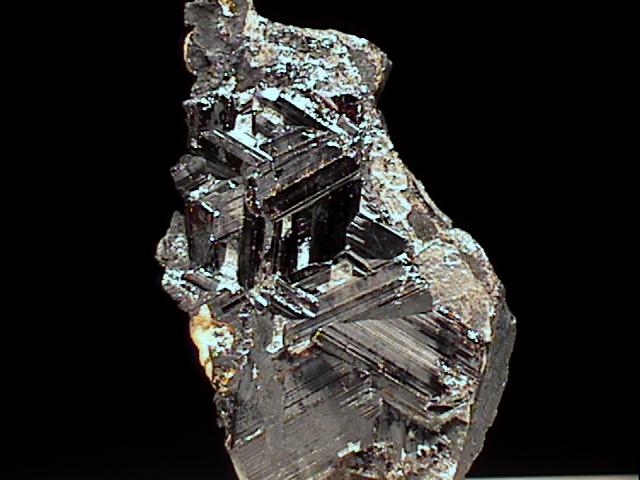
RUTILE
Specimen rut-32
$ 25.00
Dims: 1.15x0.60x0.19" (2.93x1.52x0.49cm)
Wt: 0.18oz (5.2g)
Itamarandiba, Minas Gerais, Brazil
This small specimen is a hematite crystal, one side of which is coated with two rutile crystals exhibiting a reticulated twin formation. These crystals have spokes (and striations) that form a six-rayed star (each twin is three crystals crossing at 120 degree angles).
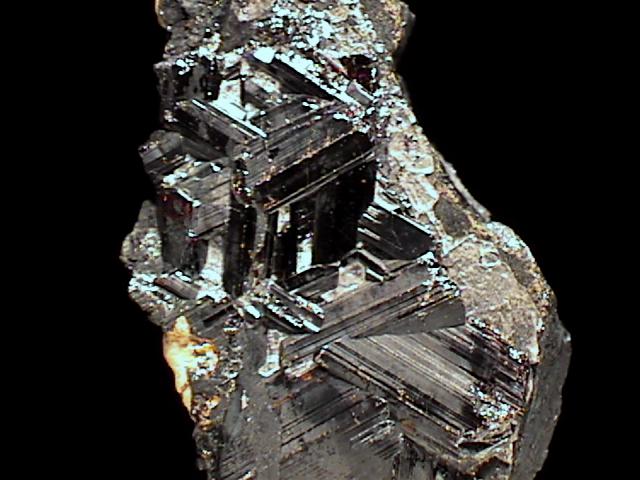
 Amethyst Galleries' Mineral Gallery MINERALS |
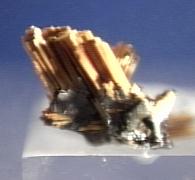
RUTILE specimen rut-1
$ 24.00
$ 24.00
Dims: 3/4" x 3/8" x 3/16"
Wt: 2 g
Bahia, Brazil
At present, this is one of the few specimens of Rutile in our stock that is not trapped in Quartz. There are three separate and distinct clusters of crystals radiating from a central point that is composed of crystalline Hematite. The longest of these clusters spans just under 1/2 inch in length. This specimen exhibits the cyclic twinning pattern of six clusters radiating away from each other at 60-degree increments along one plane. This specimen is quite small, and only three of the ideal six directions is exhibited. Think of it as one nice spray with some "twinning" accents.

rut-1 ($ 24.00)
Bahia, Brazil
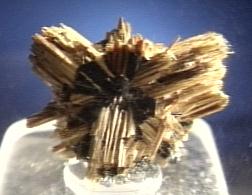
RUTILE specimen rut-2
$ 38.00
$ 38.00
Dims: 3/4" x 3/4" x 1/4"
Wt: 3 g
Ibitiara, Bahia, Brazil
The positioning of the Rutile clusters in this specimen is a really good example of the tendency of these crystals to radiate at 60-degree increments. These crystals show the classic gold color and metallic luster of Rutile, and radiate from a crystalline Hematite center. This is one of our finest specimens of Rutile, and will certainly help to round out the "Oxides" section of any collection.

rut-2 ($ 38.00)
Ibitiara, Bahia, Brazil
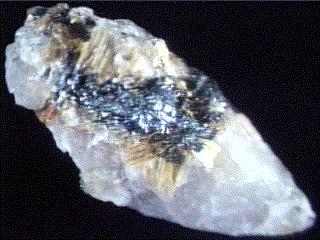
RUTILE specimen rut-3
$ 35.00
$ 35.00
Dims: 4" x 1-5/8" x 1-5/8"
Wt: 5.6 oz
Ibitiara, Bahia, Brazil
Though this specimen could be classified as "rutilated quartz," I decided that since the quartz is not crystalline, the specimen could go here. The quartz host contains a large amount of hematite from which the needlelike crystals of Rutile emerge. There isn't a great amount of Rutile, but there is an area that shows some decent crystals in a six-rayed formation that seems to be the most popular among collectors.

rut-3 ($ 35.00)
Ibitiara, Bahia, Brazil
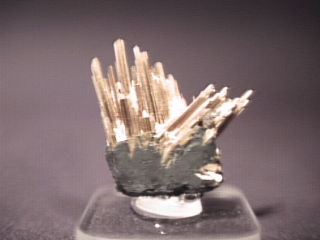
RUTILE specimen rut-4
$ 45.00
$ 45.00
Dims: 1.0" x 1.0" x 0.3"
Wt: 10.2 g w/ base
Ibitiara, Bahia, Brazil
Many long, thin bladed Rutile crystals erupt from the crystalline hematite base of this specimen. The Rutiles are congregated in two clusters that are aligned at about a 60-degree-angle from each other, as commonly occurs with this mineral. The blades are a golden color, have a metallic luster, and are opaque. They reach a maximum length of 0.6"(1.5 cm) and though many are broken, several appear to have natural, two-faced terminations. Though their hematite base does not possess the standard hexagonal tabular form, it has definite crystalline tendencies and a few complete faces. Close examination of these "prism faces" shows evidence of its basal parting. It has the dark gray color and metallic luster that is standard for hematite. The specimen has been hot-glued to a square acrylic base for display.

rut-4 ($ 45.00)
Ibitiara, Bahia, Brazil
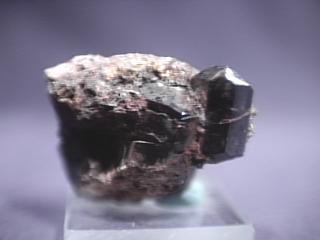
$ 100.00
Dims: 1.5" x 1.2" x 1.1"(3.8 x 3.0 x 2.8 cm)
Wt: 1.39 0z.(39.4 g)
Graves Mountain, Georgia, U.S.A.
This specimen contains 3 large, thick Rutile crystals that do not at all resemble the fine, golden needles that are often trapped in quartz crystals. These crystals are black in coloration with red-brown highlights and opaque, and have an adamantine, almost metallic luster. Only one of the crystals is more than 50% exposed from the host rock, and though it has a noticeable spot of damage on one of its termination faces, its form is excellent, with otherwise clean faces and edges. There are obvious cracks running through the crystals, but no loss of material because of them. The largest crystal of the three has estimated dimensions of 1.0"l x 0.6"d(2.5 x 1.5 cm), and could conceivably be further exposed from the host rock with some deft cleaning and matrix removal. The other two crystals are similar in size to each other, and have dimensions about 75% of the larger's. They rest in a rusty matrix rock that looks as if it may be mostly composed of more Rutile, though crushed. They are some rather hefty little crystals.

Graves Mountain, Georgia, U.S.A.
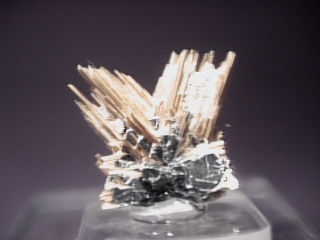
RUTILE specimen rut-6
$ 75.00
$ 75.00
Dims: 1.0" x 0.9" x 0.3" (2.5 x 2.3 x 0.8 cm)
Wt: 9.4 g w/ base
Ibitiara, Bahia, Brazil
Dozens of thin, golden Rutile needles radiate along one plane from the hematite base of this specimen. The crystals are arranged parallel to each other into two groups; these groups grow away from each other at a 60-degree angle. The crystals do not exceed 0.7" (1.8 cm) in length or 0.1" (0.3 cm) in either of the other dimensions, and appear to be in generally excellent condition, as one can see a pearly luster reflected off of their intact termination faces. There are a few which are damaged and incomplete, however. The crystals have a golden coloration and a submetallic luster, and are opaque. The hematite that makes up the base of the specimen is in excellent condition and shows a definite hexagonal crystal form. It has the dark gray coloration and metallic luster that is common for this mineral and shows little human-induced damage. The specimen is affixed to a small acrylic base with what appears to be a silica glue. It is a small but very attractive specimen, and is in better condition than most that I have seen.

rut-6 ($ 75.00)
Ibitiara, Bahia, Brazil

RUTILE specimen rut-7
$ 60.00
$ 60.00
Dims: 2.0" x 1.2" x 1.0" (5.1 x 3.0 x 2.5 cm)
Wt: 1.25 oz. (35.7 g)
Novo Horizonte, Bahia, Brazil
The Rutile needles on this specimen emanate from what almost appears to be a misshapen "book" of hexagonal hematite blades. Though it is difficult to determine, I am pretty sure that there is not much damage to the Rutile clusters, and that those crystals which were not enveloped by quartz were later worn away. They show their tendency to radiate in clusters at 60-degree-angles from each other along one plane, and have the golden color and submetallic luster that one expects. The quartz base in which some of the clusters are trapped is worthy of note. It shows excellent hexagonal prismatic form, with many well-defined edges and clean faces that have a bright, vitreous luster. The quartz has a slightly smoky-brown tint to it, and is transparent and very clear in some spots. It shows a considerable spot of damage on the tip of its largest termination, but is otherwise in excellent condition.
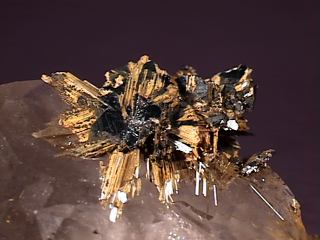

rut-7 ($ 60.00)
Novo Horizonte, Bahia, Brazil
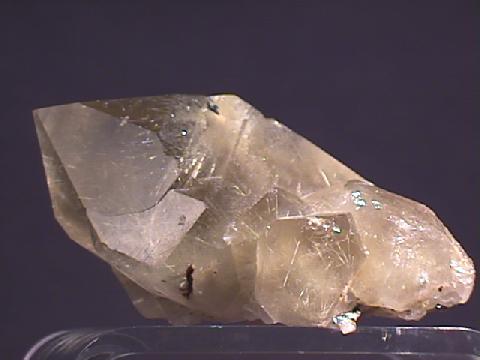
RUTILE specimen rut-8
$ 36.00
$ 36.00
Dims: 2.1" x 1.4" x 1.2" (5.3 x 3.6 x 3.0 cm)
Wt: 1.72 oz. (48.8 g)
Novo Horizonte, Bahia, Brazil
Maybe I should have put this specimen under "Quartz", but it contains enough Rutile for consideration. It consists of a cluster of 4 intergrown quartz crystals inside of which are trapped hundreds of needle-like Rutile crystals. These crystals have a golden color and a metallic luster and are well protected inside their quartz matrix. Many show signs of forming six-rayed rutile stars, though none of these appears to be complete. The quartz crystals in which they are trapped show excellent hexagonal prismatic form and no damage. They all have a vitreous luster and a very faint smoky coloration. They are also quite clear, allowing the viewer to easily see the included Rutile. There is no host rock present.
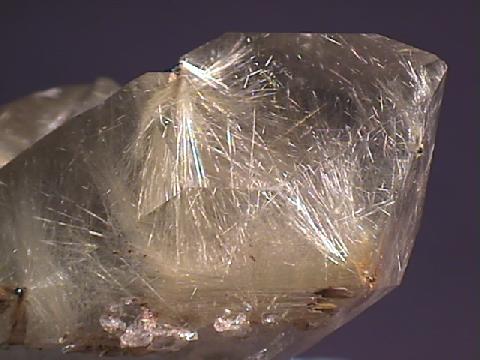

rut-8 ($ 36.00)
Novo Horizonte, Bahia, Brazil
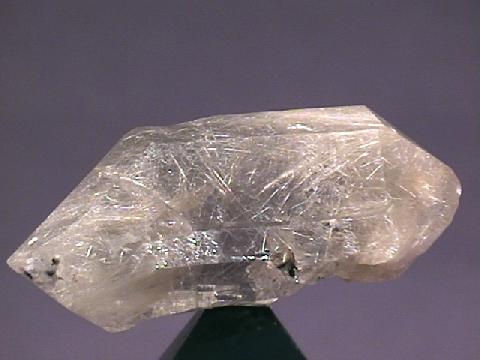
RUTILE specimen rut-9
$ 36.00
$ 36.00
Dims: 2.0 x 0.8 x 0.7" (5.1 x 2.0 x 1.7 cm)
Wt: 22.4 g
Novo Horizonte, Bahia, Brazil
This thumbnail specimen consists of a single double-terminated quartz crystal that is permeated by scores of golden Rutile needles. These needles reach lengths of over 1" (2.5 cm) and do not exceed 1 mm in diameter, as almost all are thinner than human hair. They have the standard golden-yellow coloration and metallic luster, and are in excellent condition, being protected by their quartz matrix. The quartz crystal that contains them is also in excellent condition, as only a few very small fractures make up the extent of its damage. Its hexagonal prismatic form is rather warped due to its intergrowth with other crystals, but its intact edges are straight and well-defined and its intact faces are clean, possessing the standard vitreous luster. It is colorless, transparent, and aside from the interference caused by the Rutile needles, is quite clear, as only a few small, shallow internal fractures are visible. Some of the Rutile needles grow outwards from small hematite crystals, most of which lie on the quartz's surface. A few, however, are completely included; one of these in particular is clearly visible through a termination face.
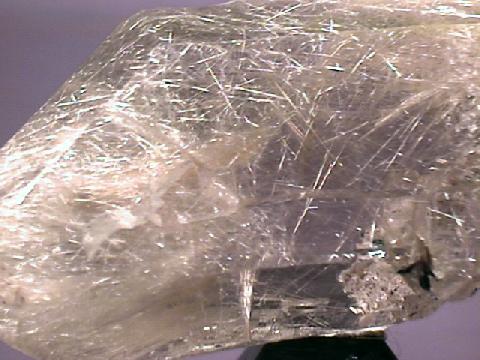

rut-9 ($ 36.00)
Novo Horizonte, Bahia, Brazil
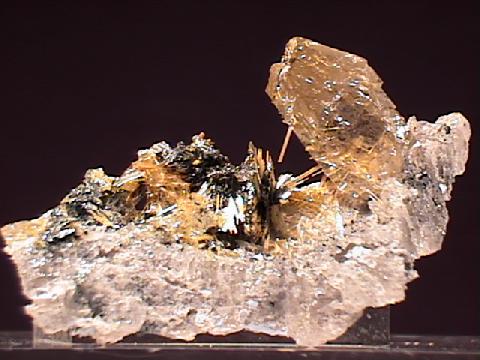
RUTILE specimen rut-10
$ 40.00
$ 40.00
Dims: 1.9 x 1.0 x 0.7" (4.8 x 2.5 x 1.8 cm)
Wt: 13.3 g
Novo Horizonte, Bahia, Brazil
This small but impressive Rutile specimen consists of dozens of Rutile needles that radiate from crystalline hematite bases on a gray, quartz-based host rock. Only a few of these needles are trapped inside a lone quartz crystal that extennds from the base rock- the rest are exposed. Most of the exposed crystals are broken, but there are many in sheltered crevices that are in excellent condition. The exposed crystals do not exceed 0.3" (8 mm) in length, whereas those trapped in the quartz reach lengths of 0.5" (1.3 cm), and possibly more. All have the beautiful golden coloration and nearly metallic luster of Rutile from this locality, and appear to have good tetragonal needle-like form, though they are very difficult to closely study. One broken crystal in particular stands out- it was broken at its base, right next to the crystal, and extends upward into the crystal. Thus, a 0.1" (3-4 mm) section of a needle extends out from the crystal like a spike.

rut-10 ($ 40.00)
Novo Horizonte, Bahia, Brazil
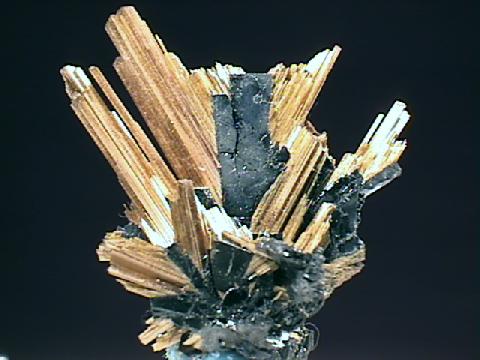
RUTILE specimen rut-12
$ 45.00
$ 45.00
Dims: 1.0 x 0.9 x 0.2" (2.5 x 2.3 x 0.5 cm)
Wt: 11.0 g w/ specimen box
Novo Horizonte, Bahia, Brazil
Several partly intergrown Rutile crystals radiate from the crystalline hematite base of this thumbnail specimen. Only a few of the Rutile needles are damaged, and those that are intact reach lengths of 0.7" (1.8 cm). Their tendency to form parallel intergrowths makes it difficult to study their form, but it appears to be good. All have the classic golden color and almost silky metallic luster of Rutile. Though crystalline in nature, the hematite blades that form the base are extremely warped and disseminated due to their interaction with the Rutile. However, they still show clean faces and the occasional straight edge, and their color and luster are standard for their species. The piece is affixed inside a cubic plastic specimen box with an adhesive putty.

rut-12 ($ 45.00)
Novo Horizonte, Bahia, Brazil
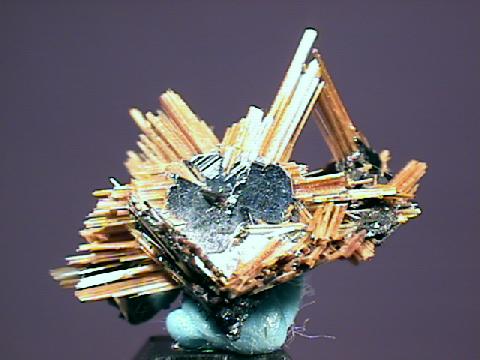
RUTILE specimen rut-13
$ 36.00
$ 36.00
Dims: 0.7 x 0.6 x 0.5" (1.8 x 1.5 x 1.3 cm)
Wt: 10.5 g w/ specimen box
Novo Horizonte, Bahia, Brazil
At least 4 different formations of Rutile twins make up this small thumbnail specimen. These crystals take on the form of the popular "star" twin- though none are more than two-thirds complete- and are generally in good condition, though a few twins are heavily damaged. The Rutile needles reach lengths of up to 0.4" (1.0 cm) and are heavily intergrown, so that their tetragonal bladed form is difficult to study. All have the classic golden color and almost silky metallic luster of their species. They extend from bases made out of hexagonal hematite blades, most of which are broken and nearly formless. There is no host rock present, and the piece is affixed inside a plastic specimen box with an adhesive putty.

rut-13 ($ 36.00)
Novo Horizonte, Bahia, Brazil
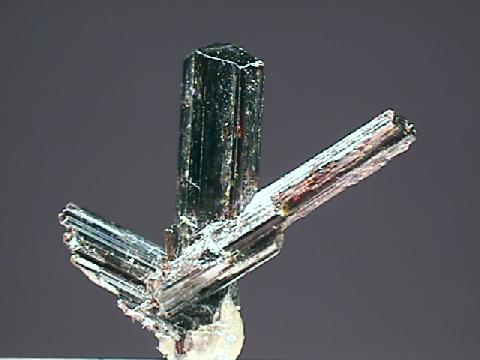
RUTILE specimen rut-14
$ 30.00
$ 30.00
Dims: 0.6 x 0.2 x 0.2" (1.5 x 0.5 x 0.5 cm)
Wt: 9.3 g w/ specimen box
Diamantina, Minas Gerais, Brazil
Three discernable Rutile crystals make up this small specimen. One of these crytals is broken and mostly incomplete, but the other two are in excellent condition. The larger of the two intact crystals measures measures about 0.6 x 0.2 x 0.1" (1.5 x 0.5 x 0.3 cm). Both have excellent though slightly warped tetragonal prismatic form, with well-defined edges and striated but clean faces that possess the standard adamantine luster. However, these crystals have a red-brown color that is so dark as to appear nearly black, though they show a small amount of translucence if viewed at certain angles under bright light. There is no host rock attached to the piece, which is hot-glued inside a plastic specimen box.

rut-14 ($ 30.00)
Diamantina, Minas Gerais, Brazil
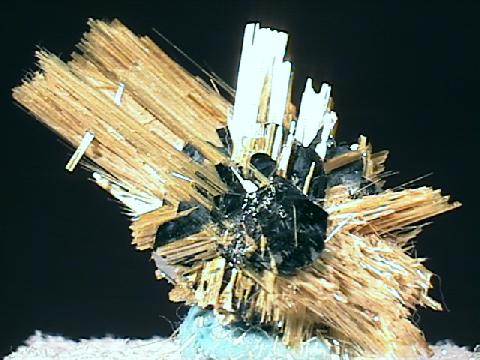
RUTILE specimen rut-15
$ 90.00
$ 90.00
Dims: 1.2 x 0.7 x 0.2" (3.0 x 1.8 x 0.5 cm)
Wt: 12.7 g w/ specimen box
Novo Horizonte, Bahia, Brazil
This thumbnail specimen consists of an incomplete Rutile "star twin" that grows out of a crystalline hematite base. The star is made up of dozens of Rutile needles, most of which appear to be in good condition. These needles reach lengths of 0.6" (1.5 cm) and are heavily intergrown with each other, making it difficult to study their tetragonal form. All have the classic golden color and metallic/silky luster of Rutile from this locality, and are obviously opaque. The hematite base from which they extend is made up of a disjointed cluster of hexagonal blades that are stacked together. All have definable form and the classic dark gray color and dull metallic luster of their species. The piece is affixed inside a plastic specimen box with an adhesive putty.

rut-15 ($ 90.00)
Novo Horizonte, Bahia, Brazil
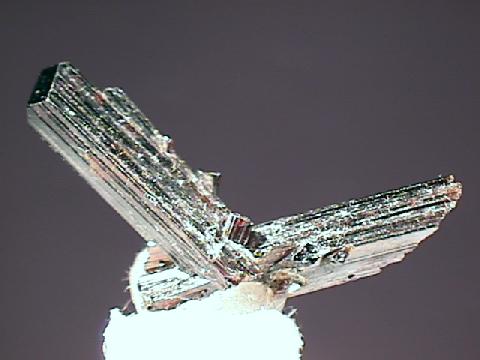
RUTILE specimen rut-16
$ 28.00
$ 28.00
Dims: 0.7 x 0.3 x 0.2" (1.8 x 0.8 x 0.5 cm)
Wt: 9.2 g w/ specimen box
Diamantina, Minas Gerais, Brazil
Though this thumbnail specimen is described as a "Rutile Twin", I personally think that it consists of two partly intergrown crystals. One of these crystals is broken and incomplete, but the other is in excellent condition, showing no damage, and measures nearly 0.6" (1.5 cm). It has the best tetragonal prismatic form that I have seen in any Rutile specimen, with well-defined edges and striated but clean faces. It has a good diamond-shaped cross-section and a shallow 4-sided domed termination. Both have a red-brown color that is so deep as to render them nearly opaque and an adamantine luster. A few shallow internal fractures betray their color. There is no host rock present, and the piece is affixed inside a plastic specimen box with a tacky wax.

rut-16 ($ 28.00)
Diamantina, Minas Gerais, Brazil
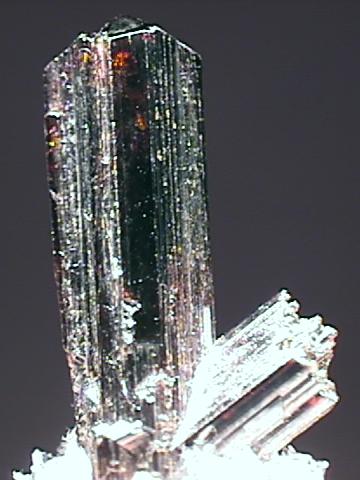
RUTILE specimen rut-17
$ 32.00
$ 32.00
Dims: 0.7 x 0.5 x 0.2" (1.8 x 1.3 x 0.5 cm)
Wt: 9.6 g w/ specimen box
Diamantina, Minas Gerais, Brazil
Two Rutile prisms make up this small thumbnail specimen. Though they are documented as a "Rutile Twin", I do not believe that they are, as what would be the twinning plane is uneven. One of the crystals is broken and mostly incomplete, but the other is in excellent condition and reaches a length of nearly 0.7" (1.8 cm). It has exceptional tetragonal form with a very good diamond-shaped cross-section, well-defined edges, and striated but clean faces. Its luster is adamantine and its color is such a dark red-brown that it appears to be nearly opaque. Only a few small internal fractures reflect enough light so that one can accurately determine its color. There is no host rock present, and the piece is affixed inside a plastic specimen box with a sticky wax.

rut-17 ($ 32.00)
Diamantina, Minas Gerais, Brazil
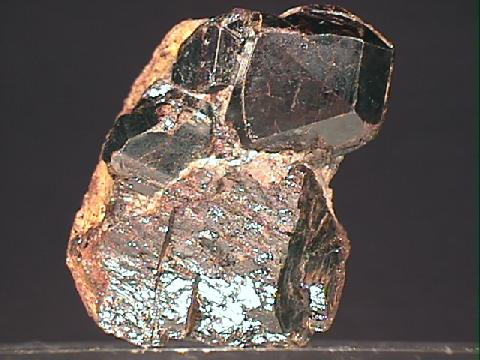
RUTILE specimen rut-18
$ 55.00
$ 55.00
Dims: 2.0 x 1.4 x 1.2" (5.1 x 3.6 x 3.0 cm)
Wt: 3.35 oz. (95.2 g)
Graves Mountain, Georgia, U.S.A.
Several incomplete Rutile crystals make up this hand specimen. These crystals are generally in fair condition, as almost all are damaged, and reach dimensions of 0.7 x 0.7 x 0.7" (1.9 x 1.8 x 1.7 cm). The largest crystal has been broken, and the two pieces slightly separated from one another- later, quartz filled in the small crevice between them. Close examination of this crystal will show a definite twinning plane in the form of a faint line that runs across the largest face. All have a dark red-brown color and a bright, greasy, subadamantine luster. The host rock is rust-stained and appears to be made up of albite.

rut-18 ($ 55.00)
Graves Mountain, Georgia, U.S.A.
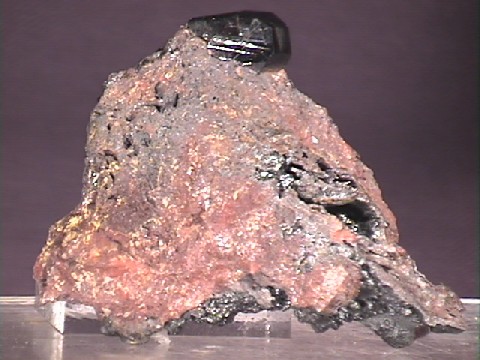
RUTILE specimen rut-19
$ 66.00
$ 66.00
Dims: 2.3 x 1.8 x 0.9" (5.8 x 4.5 x 2.4 cm)
Wt: 2.1 oz. (59 g)
Graves Mountain, Georgia, U.S.A.
A single Rutile prism rests on the goethite/hematite base of this hand specimen. This crystal has visible dimensions of 0.5 x 0.3 x 0.3" (1.3 x 0.8 x 0.7 cm) and is in very good condition, showing very little damage. Its tetragonal prismatic form is excellent, and it almost appears to be twinned according to the Spinel-Law! Its edges are exceptionally well-defined and its faces are very clean, showing a bright, adamantine luster that is practically submetallic. Its dark gray color has subtle, brick-red highlights, and the crystal is, of course, opaque. A few hollows in the reddish base rock are lined with botryoidal goethite.
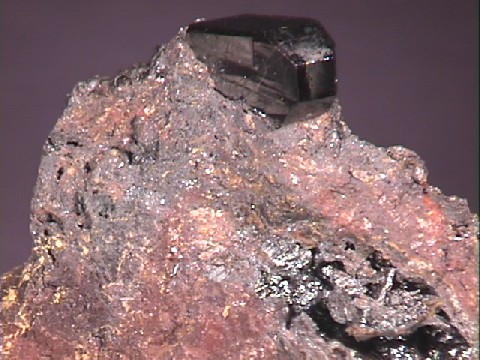

rut-19 ($ 66.00)
Graves Mountain, Georgia, U.S.A.

RUTILE specimen rut-20
$ 36.00
$ 36.00
Dims: 0.7 x 0.6 x 0.4" (1.8 x 1.6 x 1.1 cm)
Wt: 11 g w/ specimen box
Novo Horizonte, Bahia, Brazil
Sprays of parallel Rutile crystals extend off of the hematite "bases" of this thumbnail specimen. These sprays reach lengths of 0.4" (1.0 cm) and are generally in very good condition. Each spray extends at a 60-degree angle from the next, forming a few partial "Rutile Stars". Many of these rays intersect with each other, holding the hematite "bases" and in turn, the piece, together. There is no other material present. The piece is affixed inside a plastic thumbnail box with a removable putty, but trying to remove it from the box would likely destroy it.

rut-20 ($ 36.00)
Novo Horizonte, Bahia, Brazil
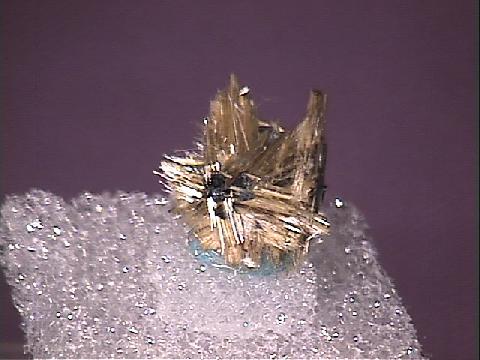
RUTILE specimen rut-21
$ 48.00
$ 48.00
Dims: 0.7 x 0.6 x 0.3" (1.8 x 1.4 x 0.8 cm)
Wt: 11 g w/ specimen box
Novo Horizonte, Bahia, Brazil
Several partial Rutile stars extend from the crystalline hematite base of this thumbnail specimen. The Rutile blades that make up the stars are in moderately good condition- many are broken and incomplete- and those that are intact have a reasonably good tetragonal bladed form, though intergrowth has warped most of them. Their golden color and bright, subadamantine/submetallic luster are standard for material from this locality. The hematite base shows some crystal form, but this is not well-defined due to its interaction with the Rutile. The piece is affixed inside a plastic thumbnail box with an adhesive putty.

rut-21 ($ 48.00)
Novo Horizonte, Bahia, Brazil
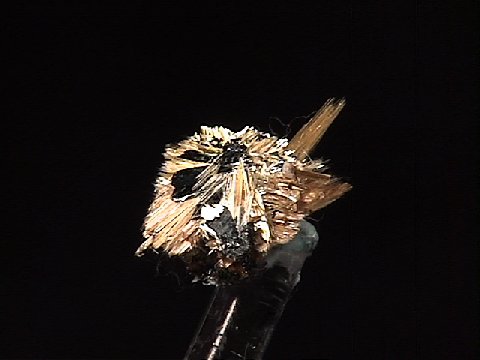
RUTILE specimen rut-22
$ 29.00
$ 29.00
Dims: 0.9 x 0.7 x 0.4" (2.3 x 1.8 x 1.0 cm)
Wt: 11 g w/ specimen box
Novo Horizonte, Bahia, Brazil
This thumbnail specimen consists of several Rutile aggregates that extend from a crystalline hematite base. The crystals that make up these aggregates measure up to 0.4" (1.1 cm) in length and are generally in good condition. Their tetragonal bladed form is rather warped due to their aggregation, but it is definable. All of the crystals have the golden color and silky, almost metallic luster that is common for material from this locality. The piece is affixed inside a plastic specimen box with an adhesive putty.

rut-22 ($ 29.00)
Novo Horizonte, Bahia, Brazil
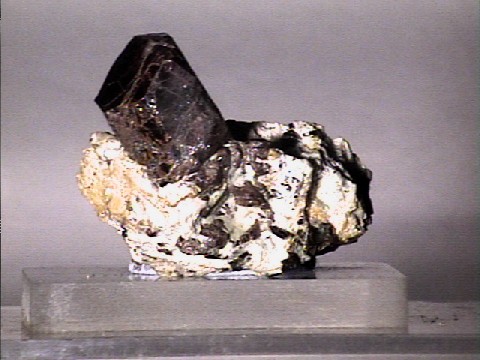
RUTILE specimen rut-24
$ 54.00
$ 54.00
Dims: 1.5 x 1.4 x 0.8" (3.8 x 3.6 x 2.0 cm)
Wt: 1.0 oz. (29 g)
Champion Mine, White Mountains, Mono County, California, U.S.A>
Several Rutile crystals are partly embedded in the pale brown host rock of this hand specimen. These crystals are generally in good condition- only one or two show fresh breakage- and the largest has dimensions of 0.8 x 0.6 x 0.5" (2.1 x 1.6 x 1.3 cm). All have excellent tetragonal prismatic form- the largest appears to be twinned. Their color is a deep gray with very strong red highlights, and their luster is a bright submetallic. All are completely opaque.


rut-24 ($ 54.00)
Champion Mine, White Mountains, Mono County, California, U.S.A>
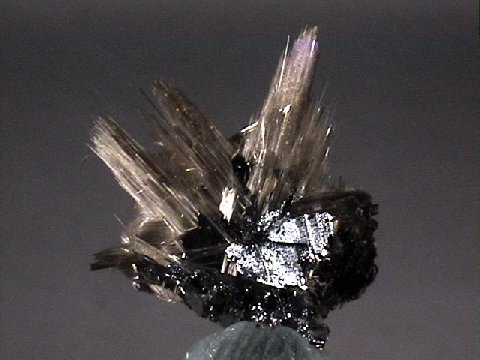
RUTILE specimen rut-23
$ 25.00
$ 25.00
Dims: 0.8 x 0.7 x 0.3" (1.9 x 1.7 x 0.7 cm)
Wt: 2 g
Novo Horizonte, Bahia, Brazil
This small thumbnail piece consists of a cluster of Rutile needles that extend from a crystalline hematite base. These needles reach 0.4" (1 cm) in length and are in good condition. Their tetragonal form is difficult to study due to intergrowth and their small size, but is definable. All have a golden-yellow color and a shiny, nearly metallic luster. The hematite base actually has good hexagonal form on one side, and is affixed inside a plastic specimen box with a removable putty.

rut-23 ($ 25.00)
Novo Horizonte, Bahia, Brazil
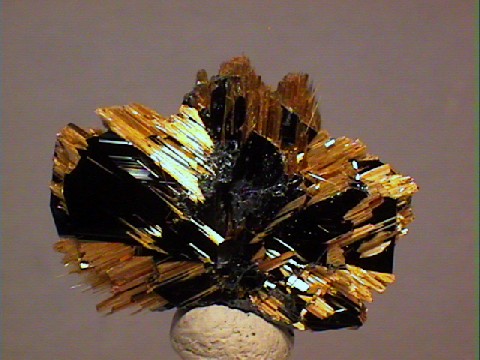
RUTILE specimen rut-25
$ 84.00
$ 84.00
Dims: 1.2 x 0.9 x 0.3" (3.0 x 2.3 x 0.9 cm)
Wt: 0.4 oz. (10 g)
Novo Horizonte, Bahia, Brazil
This flat thumbnail piece consists of several "sheaves" of Rutile blades that extend geometrically along a flat plane from a crystalline hematite base. These sheaves do not exceed 0.5" (1.2 cm) in length and appear to be in good condition, though scores of tiny Rutile shards lie on and around it in its packaging. All show the classic golden color and semimetallic luster of specimens from this locality, and all are completely opaque. Their tetragonal form is quite warped due to their compact nature and the conditions under which they grew, but they show the standard habit of radiating at 60-degree intervals along a single plane from a single point, creating a partial "Rutile Star". The hematite base shows surprisingly good hexagonal tabular form where its edges are exposed, and has the standard gray color and dull metallic luster.
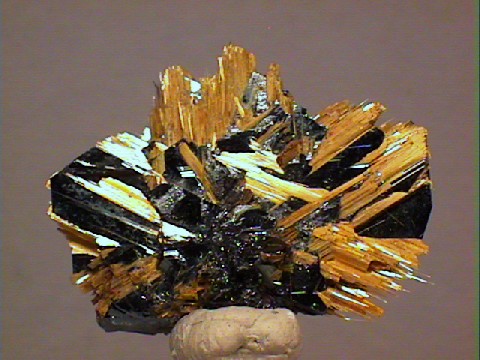

rut-25 ($ 84.00)
Novo Horizonte, Bahia, Brazil
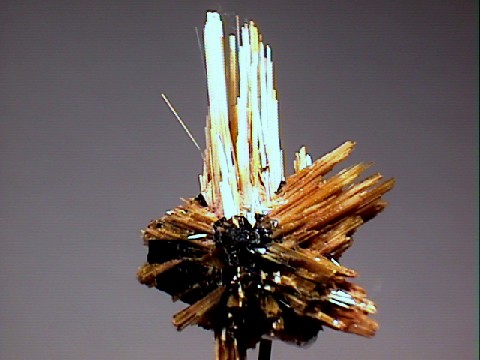
RUTILE specimen rut-26
$ 60.00
$ 60.00
Dims:1.0x0.7x0.1" (2.5x1.8x0.3 cm)
Wt: 0.6oz. (16g)w/box
Novo Horizonte, Bahia, Brazil
This specimen consists of a rutile "sixling" growing from a crystalline hematite base. The rutile crystals are needle-like and are golden in color. The longest needles of rutile reach 0.6" (1.5cm) in length. There is only very minor damage associated with this piece. It is mounted in a clear plastic "perky" box.


rut-26 ($ 60.00)
Novo Horizonte, Bahia, Brazil
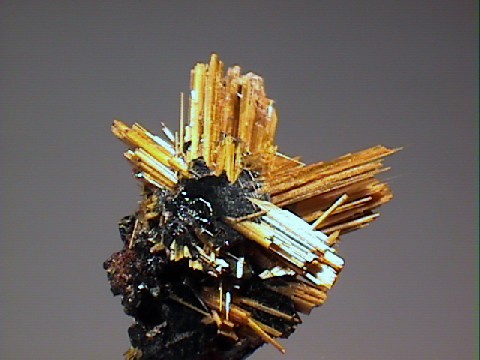
RUTILE specimen rut-27
$ 29.00
$ 29.00
Dims:0.7x0.5x0.1" (1.8x1.3x0.3 cm)
Wt: 0.4oz. (10g)w/box
Novo Horizonte, Bahia, Brazil
This specimen is another of the interesting "sixling" crystals growing from a hematite base that this locale is famous for. Four of the six "arms" on this crystal are distinct; the remaining two are absent. The rutile crystals are golden in color, the longest extending 0.3" (0.8cm) in length. This specimen shows no damage.

rut-27 ($ 29.00)
Novo Horizonte, Bahia, Brazil
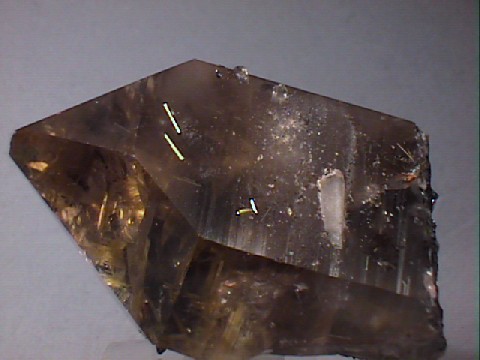
RUTILE specimen rut-28
$ 84.00
$ 84.00
Dims:3.3x2.2x1.6" (8.4x5.6x4.1 cm)
Wt: 8.0oz. (227g)
Novo Horizonte, Bahia, Brazil
This specimen consists of hundreds of golden rutile crystals included within and growing up through a smoky quartz crystal with hematite crystals. The front of the quartz crystal is undamaged, as is the termination. However, the back of the specimen is so covered with hematite and rutile crystals that very little quartz is visible. The quartz is highly translucent when held up to a light. The best rutile crystals are visible through the termination of the quartz crystal. They appear to reach at least 0.5" (1.3cm) in length.
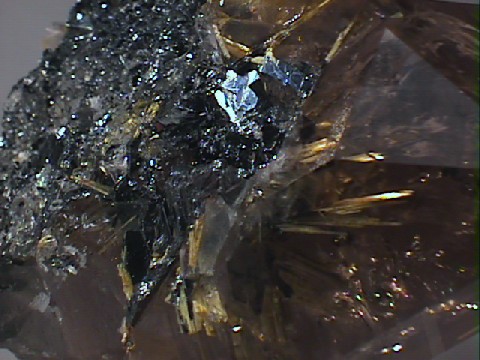

rut-28 ($ 84.00)
Novo Horizonte, Bahia, Brazil
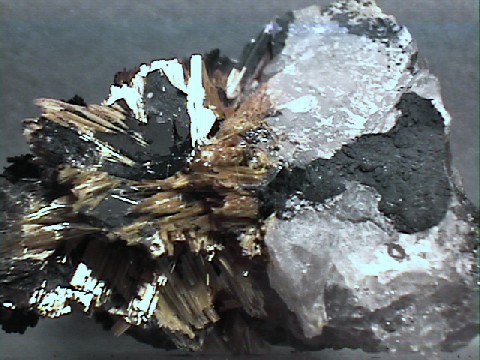
RUTILE specimen rut-29
$ 25.00
$ 25.00
Dims: 2.1x2.0x1.3" (5.3x5.0x3.3cm)
Wt: 2.95 oz. (83.6g)
Novo Horizonte, Bahia, Brazil
Numerous golden rutile needles spread out of the hematite on this specimen. Most of the rutile is in several intergrown 6-rayed stars, none of which is complete. Most of the rutile crystals are damaged (it is so fragile that damage is nearly unavoidable), and there will undoubtedly be more broken needles of rutile in the shipment when it arrives in your care. The host rock is quartz, the hematite does not show crystal form, and appears to have a coating of goethite in the form of tiny stalactitic growths.
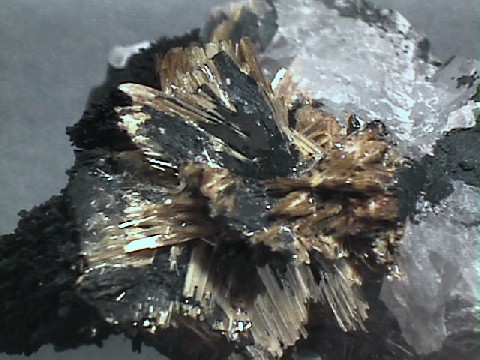

rut-29 ($ 25.00)
Novo Horizonte, Bahia, Brazil

RUTILE specimen rut-30
$ 84.00
$ 84.00
Dims: 2.95x1.46x0.59" (7.5x3.7x1.5cm)
Wt: 2.52oz (71.2g)
Itamarandiba, Minas Gerais, Brazil
This is a very nice and unusual specimen of rutile. It is a reticulated twin formation, in which broad, flat rutile crystals are intergrown at exactly 60 degree angles. These crystals are up to a millimeter thick atop a flat piece of hematite. The crystals are nicely striated, adding visual strength to the six-sided pattern. There are apparently two slightly different orientations of the crystals, which are independently preserved over significant distances in this specimen.
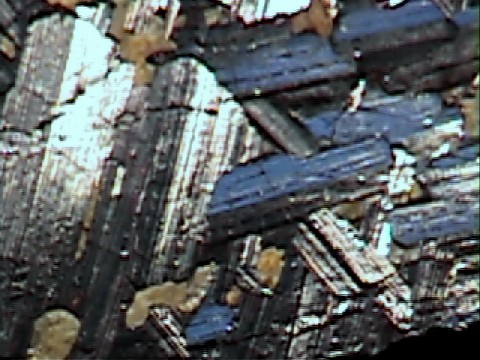

rut-30 ($ 84.00)
Itamarandiba, Minas Gerais, Brazil
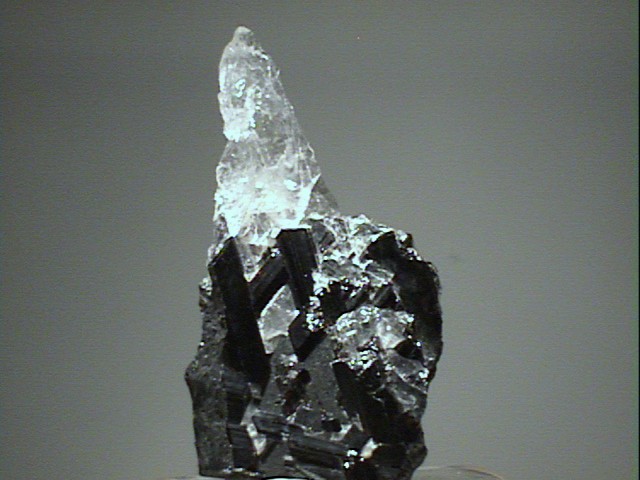
RUTILE specimen rut-31
$ 35.00
$ 35.00
Dims: 2.00x1.10x0.31" (5.08x2.80x0.79cm)
Wt: 0.67oz (19.1g)
Itamarandiba, Minas Gerais, Brazil
This is a piece of hematite with numerous reticulated twin crystals of rutile on both flat surfaces. The rutile crystals all share one of three orientations at 120 degree angles to each other. This property extends to the few crystals on the back side, which is either a coincidence or an indication of host aligned crystals on a single crystal of hematite. There is also a fragment of a clear quartz crystal attached to one end.

rut-31 ($ 35.00)
Itamarandiba, Minas Gerais, Brazil

RUTILE specimen rut-32
$ 25.00
$ 25.00
Dims: 1.15x0.60x0.19" (2.93x1.52x0.49cm)
Wt: 0.18oz (5.2g)
Itamarandiba, Minas Gerais, Brazil
This small specimen is a hematite crystal, one side of which is coated with two rutile crystals exhibiting a reticulated twin formation. These crystals have spokes (and striations) that form a six-rayed star (each twin is three crystals crossing at 120 degree angles).


rut-32 ($ 25.00)
Itamarandiba, Minas Gerais, Brazil